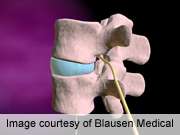The effect of osteoporosis therapies (bisphosphonate drugs and intermittent parathyroid hormone) on spinal fusion is unclear, according to a review published in the February issue of The Spine Journal.
(HealthDay)—The effect of osteoporosis therapies (bisphosphonate drugs and intermittent parathyroid hormone [PTH]) on spinal fusion is unclear, according to a review published in the February issue of The Spine Journal.
Brandon P. Hirsch, M.D., of the University of Miami/Jackson Health System, and colleagues conducted a systematic review of the literature from 1980 to 2011 to assess the potential impact of bisphosphonates and PTH on fusion rate and quality in spinal arthrodesis. Eighteen animal studies and one clinical trial were included in the review.
The researchers found that most animal studies showed that bisphosphonates have no significant impact on fusion rate but that treatment may result in less histologically mature fusion mass; the impact of these changes on fusion mass biomechanics was unclear. Based on the human study, bisphosphonates had no impact on clinical outcome but may have increased the radiographically defined fusion rate. PTH improved the fusion rate and fusion mass microstructure in animals, but data were lacking for the effect on fusion mass biomechanics. There were no studies that assessed the impact of PTH on spine mass in humans.
"In the absence of conclusive human data relating to spine fusion, we recommend the continuation or initiation of these therapies in patients based on their indication for the treatment of osteoporosis, without regard for a recent or impending spine fusion procedure," the authors write. "However, on the basis of preclinical data, we believe that anabolic agents may offer an advantage over antiresorptive medications in osteoporotic patients undergoing spine fusion."
One author disclosed financial ties to the biopharmaceutical industry.
More information:
Abstract
Full Text (subscription or payment may be required)
Journal information: Spine Journal
Health News Copyright © 2013 HealthDay. All rights reserved.
























